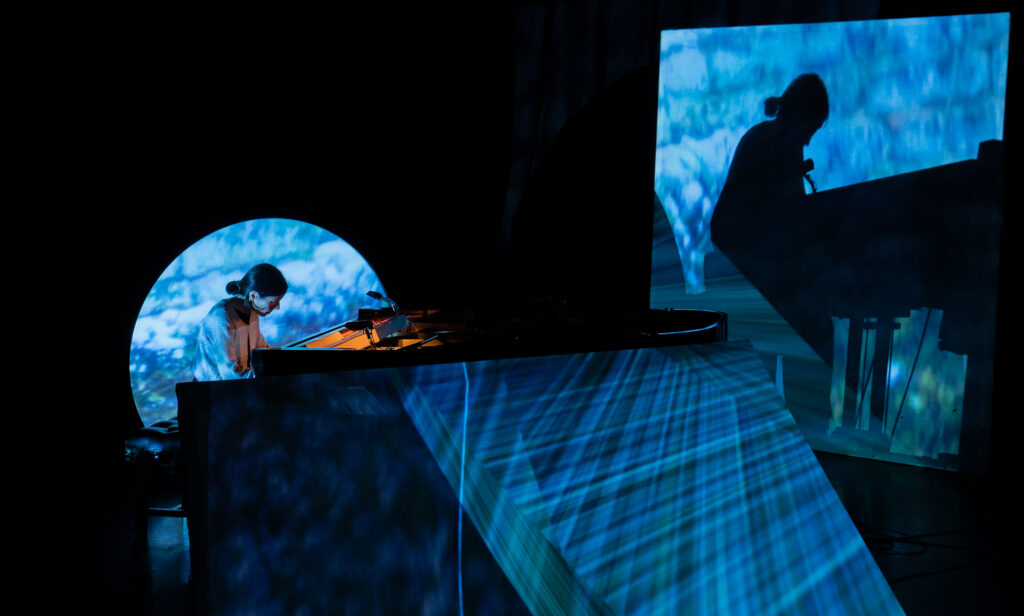12 miniatures | 45 min.
Ludic Inventions explores innovative and inventive ways to synergize visuals and sound as a malleable live immersive performance. This confluence of mediums have been brought together by an international team of music/media creators. It is playfully provocative and sensitive by turns. It is challenging, yet fun. At the centre is the piano. This is extended and re-invented through sonic manipulation, preparations, improvisation and the dialogue between the human performer and electronics. Sound and visuals are interwoven and playfully juxtaposed. Taking the start from Colin Riley’s miniatures for piano, Ludic Inventions is a collaborative project. It involves further development by the composer (electronics), working closer with Agnese Toniutti (piano preparations/improvisation), Kristijonas Dirse (film) and Sabina Covarrubias (live video performance). Every performance of Ludic Inventions will be individual. It lasts between 40-60 mins.






Colin Riley
Agnese Toniutti
Kristijonas Dirsė
Sabina Covarrubias




Colin’s music draws on a range of elements including new technologies, improvisation, song-writing and large-scale classical form. Recent works include a double cello concerto Warp and Weft (Gabriella Swallow/Guy Johnston), In Place (Melanie Pappenheim), and Hearing Places (BBC National Orchestra of Wales). He has also collaborated with diverse artists such as drummer Bill Bruford and poets Michael Rosen and Benjamin Zephaniah.
He is Reader in Music at Brunel University London, and also runs his own label, Squeaky Kate. He writes a regular blog about composing called Riley Notes and his music is published by Composers Edition.
‘Riley is that rarest of birds, a genuine original.’ London Jazz Blog
Agnese Toniutti is an Italian pianist specialized in contemporary and 20th Century music. Her work often investigates the complementarity of composition and improvisation in musical creativity, both in the author and the interpreter’s case. Cage, Scelsi, Cardini are some of her favorites; her incursions into the territory of improvisation, performance, and extemporary composition, are also encouraged by studying Seventies’ art movements. Her collaborations often include other artistic disciplines (acting, photography, dance, visual arts and multimedia).
Among her recent projects is the release of Subtle Matters (Neuma Records, 2021), a recording where she re-interprets the “timbre-piano” invented by Lucia Dlugoszewski and the verbal scores by Philip Corner.
As a soloist and chamber music pianist, she performed in several venues and international festivals in Italy, Europe, and the USA.
www.agnesetoniutti.com
Born in Vilnius (Lithuania) in 1992, Kristijonas is an audiovisual artist, filmmaker and photographer. In his work he combines music and sonic art with the visual expression in narrative and non-narrative films, photography and audiovisual installations.
While studying Film and Music BA at Brunel University, he worked on interdisciplinary art projects and festivals with students and lecturers from the School of Arts (Jennifer Walshe, Christopher Fox, Colin Riley, Bob Gilmore).
Music plays a major role in his storytelling. It is particularly present in his collaborations with a Lithuanian composer Dominykas Digimas.
Psychogeographic approach to street videography, exploring the city as a character was the basis of imagery for “From Another Point of View” or “This Order Goes Wrong”. Their recent work “Why Does This Appear” explores the question of the subjectivity in memories, as well as the docu-fiction storytelling in a silent music film form.
Sabina Covarrubias, PhD, is a composer, multimedia artist and researcher in the field of computer music. Covarrubias has composed visual music and electroacoustic music in the genres of mixed music, she has also created audio-visual installations and audio-reactive and audio-generative visuals for music. Her electroacoustic music work is based on her mastery of spatialization, sound and rhythmic synthesis techniques using computer tools as well as analog and modular synthesizers. Her visual-music work is based on the synthesis and real-time processing of visuals from data extracted from audio analysis. Her visual-music work has been reviewed and analyzed in major magazines such as MIT’s Computer Music Journal, 2020.
In general, her work is characterized by the fusion of elements of traditional music from Mexico and Senegal, Africa, with other musical traditions and new technologies, and by the visualization of musical elements in real time, for more information, please visit : www.sabinacovarrubias.com
The project is supported by Brunel University London, Santander Scholarship for Brunel Alumni and Sound Festival Scotland.









